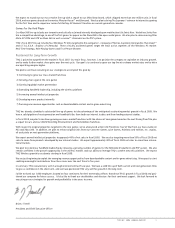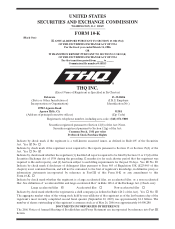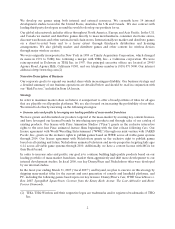THQ 2006 Annual Report Download - page 15
Download and view the complete annual report
Please find page 15 of the 2006 THQ annual report below. You can navigate through the pages in the report by either clicking on the pages listed below, or by using the keyword search tool below to find specific information within the annual report.7
ranges from 6 to 9 months, Nintendo DS ranges from 9 to 12 monthsand wireless games range from 6 to 9
months. The development cycle for the next generation of games on Microsoft Xbox 360 can range from 12
to 36 months depending on the overall complexity and scope of the game, and we anticipate a similar
development cycle for the next generation of games on Sony PlayStation 3 and Nintendo Wii. These
relatively long development cycles require that we assess whether there will be adequate retailer and
consumer demand for a game well in advance of its release. The investments in such development, prior to
reaching technological feasibility, are recorded as product development expenses in our consolidated
statement of operations. We had product development expenses of $84.2 million in fiscal 2006, $73.0
million in fiscal 2005 and $36.9 million in fiscal 2004.
Upon completion of development, each game is extensively play-tested by us to ensure compatibility with
the appropriate hardware systems and configurations and to minimize the number of bugs and other
defects found in the products. If required, we also send the game to the manufacturer for its review and
approval. To support our products after release, we provide online access to our customers on a 24 hour
basis as well as operator help lines during regular business hours. The customer support group tracks
customer inquiries, and we use this data to help improve the development and production processes.
Manufacturing
Other than games that we release for sale on PCs or wireless devices, our video games are manufactured
for us by the platform manufacturers or their authorized vendors. We contract with various PC replicators
for the manufacturing of our PC products.
The platform game manufacturing process begins with our placing a purchase order with a manufacturer.
We then send the software code and a prototype of the game to the manufacturer (together with related
artwork, user instructions, warranty information, brochures and packaging designs) for approval, defect
testing, and manufacture.
We are required by our platform licenses to provide a standard defective product warranty on all of the
products sold. Generally, we are responsible for resolving, at our own expense,any warranty or repair
claims. We have not experienced any material warranty claims, but there is no guarantee that we will not
experience such claims in the future.
Marketing and Sales
Our marketing activities vary depending upon whether a video game title is based upon a licensed or an
original property. A licensed property has pre-existing brand popularity and thus often requires less initial
effort by us to promote. Our marketing efforts for titles based upon original properties begin well in
advance of a title’s release and focus on building positive awareness of our game concepts with consumers
and retailers. We conduct consumer and retail research, which provides us with feedback to position a title
prior to its release. Our public relations promotional activities for original titles in fiscal 2006 included
coverage in broadcast, print and online media targeting enthusiast, lifestyle and major mainstream outlets.
Additionally, we continue to increase our corporate public relations efforts by establishing relationships
with leading technology and business reporters.
Our marketing efforts for products released in fiscal 2006 covered a broad range of media including,
television, print, in-theater, radio, internet advertising and promotional events. Most of our major new
releases in fiscal 2006 received television support. Our games were also supported by promotional activities
such as trailers, demo discs, over-sized boxes, standees, posters, pre-sell giveaways at retail stores, game
kiosks at sporting and outdoor events, rebates and contests with national packaged goods companies and
fast food restaurants, and co-marketing efforts with the hardware manufacturers. Our games are promoted
to retailers by display at trade shows such as the annual Electronic Entertainment Expo (E3) and select
retailer specific trade shows. We also conduct print and cooperative retail advertising campaigns for most
























